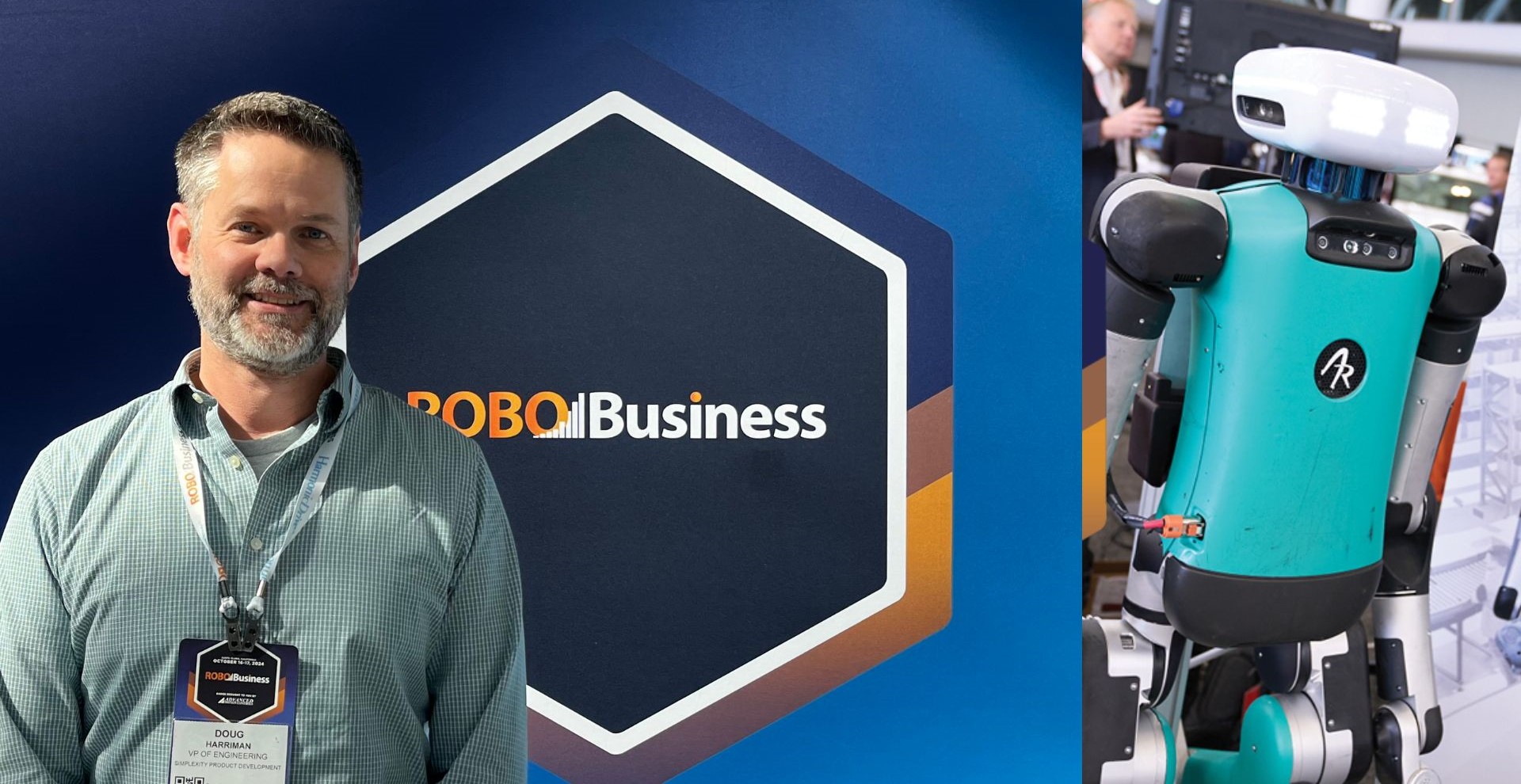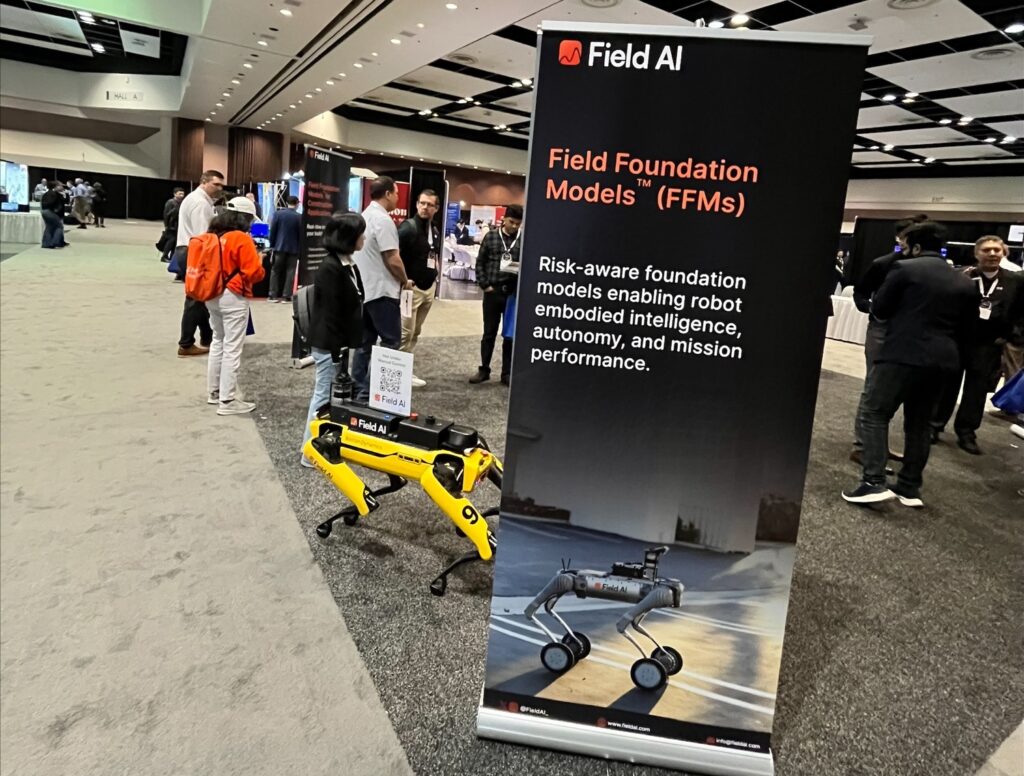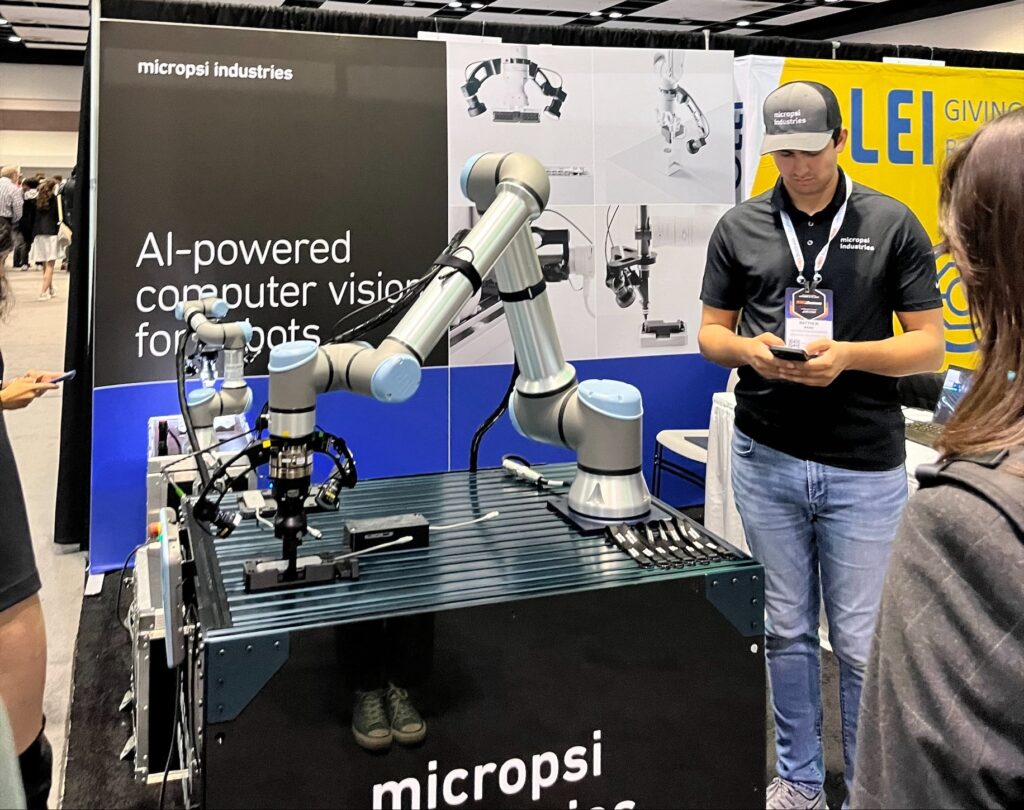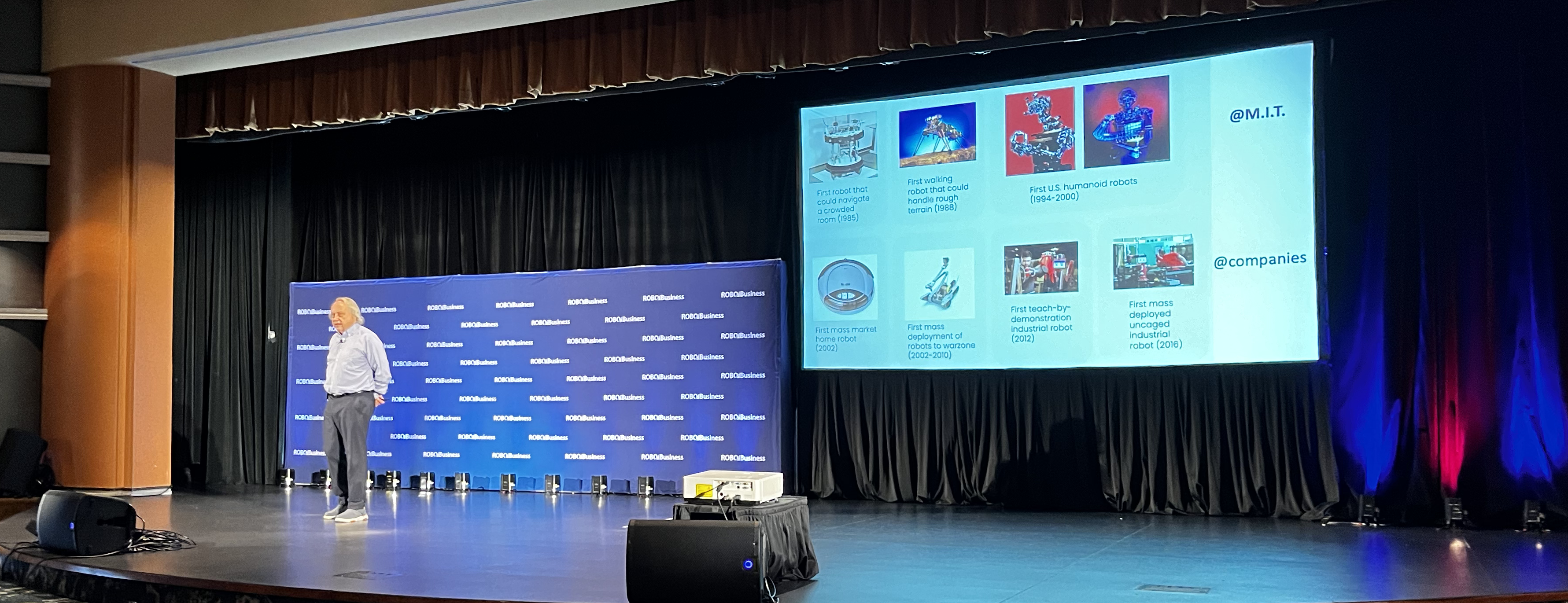I had the privilege of attending ROBOBusiness 2024 in Santa Clara, California on October 16th and 17th. The conference featured a wide variety of speakers and exhibitors from companies that ranged from AI software startups to large industrial component suppliers. From my vantage point as a designer and implementer of robotic and automation systems, it was a fascinating event. Below are my four key takeaways from the conference.
#1: AI in Robotics – There’s Work to be Done
Like every other industry, the robotics industry is being heavily impacted by the advances in artificial intelligence, and it brings the potential of some great advances. The focus on AI for robotics centered on two major themes:
- Robustness to variability and handling unstructured environments. AI enhanced machine vision applications are helping robots to better understand their environment and to gracefully adapt to changes. While traditional vision processing applications can be extremely sensitive to lighting changes, breaking when the sunlight through a skylight changes, AI based approaches can be trained to understand their environment under a wide range of conditions.
- Companies like Micropsi and ThoughtForge have developed AI software to help robots adapt to variations in a wide variety of task conditions, making the robots’ operation robust to the day-to-day changes expected in real world environments without the need to make software updates or to retrain them.
- The democratization of robot system programming. Inverse kinematics, path planning, vision processing, grasping and manipulation? All are complex topics that need to be tackled when programming a robot. That’s before you try to integrate an AI software stack on top of it all. Max Cao of Jacobi Robotics pointed out that there are four million robotic arms deployed in industry, 80% of which are programmed manually. There are a variety of companies using AI to simplify the task of programming robots.
- The aforementioned Jacobi Robotics, a spinout of Berkely AI Research (BAIR) (Go Bears!) has developed software tools for advanced robot path planning that simplify the job of programming robots to operate in constrained environments. Of particular note, these algorithms are optimization algorithm based, not AI based, allowing Jacobi to prove safety of the algorithms, an unsolved problem in AI. The really interesting point is that Jacobi can provide AI software to plan tasks, but then run those commands through their path planner to guarantee safety.
- Sergey Levine of Berkely AI Research (BAIR) and Physical Intelligence delivered a keynote address about some amazing work his team is doing with generative AI allowing their robotic systems to reason about high level instructions, plan a series of steps to accomplish the task at hand, then to successfully perform the task. One example was a human telling a robot to “put the eggplant in the bowl”. The system was presented with a workspace containing several pieces of plastic fruit and a silver bowl. The system figured out what the eggplant and bowl were, then determined the operations needed to pick and place the eggplant, all from one simple verbal command.
As these companies continue to refine their tools, the tasks required to successfully program a robot are shifting. Amit Goel of NVIDIA described the future robotics programming workflow as moving from directly programming the robot to gathering and curating data for training, then giving higher level commands to the AI which directly controls the robot. This follows a common technology trend: as tools advance, problems are solved at higher and higher levels of abstraction.
The largest challenge in implementing AI for robotics is simply the lack of relevant training data. The first generation of LLMs to become publicly available were focused on written language. Given 20+ years of the internet, the full corpus of humanity’s written language was accessible for training the models. That same level of training data is not available for robots. Generating the proper data takes time and is being tackled. When I attended the ARM Institute annual members meeting back in September 2024, the creation of this foundational data set was a major theme, and will be the subject of one of ARM’s Project Calls later in 2024.
One very interesting solution for speeding up the process of gathering training data is using high fidelity 3D simulations of the real world to generate synthetic, but physically realistic training data. This can yield a massive speedup in the generation of training data. The concept was explained well in the Tesla AI Day 2022 presentation.
#2: Humanoid Robots Aren’t There Yet
During the keynote panel on day one of the conference, humanoid robots were a major topic of conversation. Humanoid robots have been a topic with significant hype recently, in particular with Tesla’s latest event highlighting their Optimus humanoid robot, which was later revealed to be teleoperated by humans.
The main takeaway from the panel discussion is that humanoid robots are a long way off from being a product widely adopted by anything more than extremely specific applications. John Bubnikovich of ABB Robotics put it succinctly: “Near term, they’re not commercially compelling.” Eric Truebenbach of Teradyne Robotics Ventures asked (paraphrasing): why would I want to pay that much for performance that slow?
The panel was not all downbeat on humanoid robots, however. Mr. Trubenbach pointed out that humanoid robots have been a “great platform for innovation”, while Mr. Goel of NVIDIA noted “Learnings from humanoids tend to translate easily into other, more targeted applications.”
Harkening back to a point made by Rodney Brooks of RobustAI in the opening keynote, it typically takes 40+ years for a technology to go from the first lab demonstrations to being a commercially viable product. It seems that humanoid robots have a while to go before they’re ready for the broader market.
#3: There’s Good Business to be Done in Robotics Today
It shouldn’t come as a surprise to anyone that a conference named “ROBOBusiness” has an affinity for attracting serious businesses. While there were some great insights into technologies on the verge of, hopefully successful, commercialization, there was a strong focus on commercial solutions to real problems.
As a little background, this blog post from Oct 1, 2024 by Michael Ferguson provides some good context. Mr. Ferguson noted:
Much of the really interesting stuff with computers and the internet started to happen when people who weren’t just computer nerds were able to build companies in the space. I think the same thing could happen for robotics.
These next generation robotics companies will have a founding team with domain experts in whatever problem the robot is solving. These companies probably won’t even be called robotics companies. They’ll be healthcare automation startups, or 3PL startups, etc.
Several speakers noted the same trend at ROBOBusiness and there were several examples of robotics companies offering targeted solutions to specific problems:
Farm-ng Amiga
The Amiga is an agricultural robot that is highly configurable. Farm-ng’s AI implementation for the robot seems to be targeted at limited autonomous navigation in the field and between fields. It’s highly configurable for the farmer too. The robot is more of a platform that can be modified to support different crop row spacing, and a variety of implements and carrying options like platforms, beds, seats, etc. This looks to be offered as a tool that the farmer can modify to suit their needs, and also to allow other companies to offer application specific implements.
Watch an overview of Farm-ng Amiga in action
RobustAI Carter Pro
The Carter is targeted at warehouse pick operations, i.e. situations where operators are traversing a warehouse fulfilling orders by picking from various bins and shelves. The Carter has an AI enabled vision system for safety and to support navigation within the warehouse. Beyond that, it’s just a really smart mechatronic product design addressing the physical and cognitive loads placed on warehouse pick operators. It doesn’t look like a robot, but it addresses a real need. Per the keynote panel comments by Joan-Wilhelm Schwarze of DHL, RobustAI spent a lot of time with DHL understanding the needs of warehouse operators to develop a targeted solution.
It’s refreshing to hear the keynote panel get to the core of what is needed to have a successful robotic business. The most important thing a robotic business needs to do is what any business needs to do: deliver value to your customers.
Mr. Schwarz highlighted:
- Know your customer, deliver value. Create problem targeted solutions.
- Build your proof-of-concept. Test it. Don’t be afraid to change it as you learn. Go for market fit.
- Address the on-robotic issues: service contracts, IT integration and integrating with other infrastructure. In particular, DHL doesn’t want to have to physically modify its hundreds of warehouses just to use your technology. You need to adapt to their physical infrastructure.
Mr. Goel of NVIDIA added: do your MVP and address your #1 use case. How will you scale into your #2 use case and beyond? Build/test/iterate.
Watch the RobustAI Carter Pro in action
#4: In the Age of AI, Fundamentals are Still Fundamental
While AI is changing many things in our world, AI is not going to solve every problem for your business.
With respect to robotic hardware, there were lots of well attended talks on motors, gearboxes, manufacturing, scaling a business, etc. There were lots of companies on the expo floor selling robotic hardware components also. Robots are complex beasts and there’s a lot to learn.
Claire Delaunay, CTO of Farm-ng hit a very important point:
We are more than our brains. Our bodies are incredible machines. It is a disservice to our amazing bodies to think that we are only our brains. AI is important but will not solve all of the problems in robotics.
While it would be foolish to ignore what AI can do for your robotics business, unless you have a software only company, robots require hardware, and well-designed hardware will always be critical to a successful robotics company.
Wrapping Up My Key Takeaways from ROBOBusiness
Whether your company sells robots or addresses some portion of the overall robotic technology stack, the ROBOBusiness conference is a great place to see what’s going on in the industry, both what’s coming next, and what other companies are doing right now to generate their revenue.





